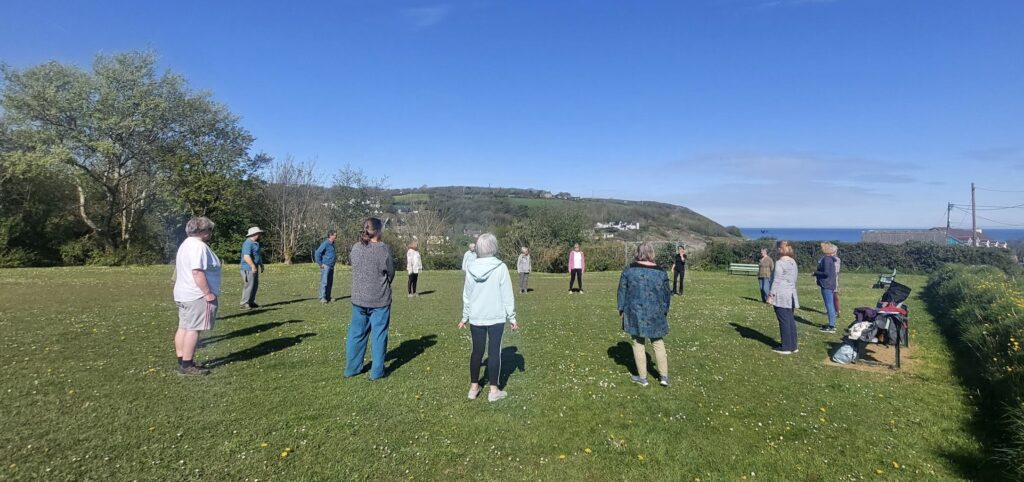One Breath to Unite us All: World Tai Chi and Qigong Day
Maria Teresa Agozzino PhD. Senior Instructor, Tai Chi for Better Health
Each year at 10am (local time) on the final Saturday of April, practitioners of tai chi and qigong worldwide mark the day with special events and demonstrations in order to share their peaceful practice and disperse positive energy.
The first global event was held in 1999. Founders William Douglas and Angela Wong Douglas established World Tai Chi and Qigong Day in order to:
- To educate the world of the profound health and healing benefits of tai chi and qigong for individuals, communities, and nations.
- To thank Chinese culture for creating and sharing these profoundly valuable gifts with the world.
- To bring together people across racial, economic, religious, and geo-political boundaries, to join together for the purpose of health and healing, providing an example to the world.
- To give a powerful example of how the power of the internet can be used to foster global health and healing (1).
What are Tai Chi and Qigong?
The origins of practice can be traced to more than 4,000 years ago, and therefore multiple existences and variations exist and in many parts of the world.
Translated as Supreme Ultimate, tai chi shares historical commonalities with martial arts with an emphasis on learning long sequences of forms that flow from one move to the next in synchronicity with the breath.
As a health practice, the focus of qigong is on rooting and repetition. In fact, technically, tai chi can be categorised as qigong, and for the remainder of this article, I shall use the umbrella term qigong to encompass all forms and variations of practice.
Qigong can be interpretated as working with breath or energy practice. Qi can be translated into English as breath, air, vital energy, or life force; gong as work or effort. Therefore the practice of qigong aligns an awareness of breath, intention, and movement.
There are dozens of qigong exercises – some individual, others in short sequences – from the traditional Ba Duan Jin (8 Brocades) and Yi Jin Jing (12 Tendon-Muscle Strengthening routines) to the contemporary repetitious sets of Shibashi (18 moves).
Deep Roots
Qigong evolved from the desire to lead a good and long life; to ensure not only longevity but also vitality. Daoist principles (The Way), based on curiosity and observation of nature and cosmology thousands of years ago, gave rise to what we understand about qi. Thus, classic Daoist theory and lifestyle influence our belief system and inform our practice today; our drive to produce and maintain abundant qi and lead healthy meaningful lives.
Steeped in the philosophy and physiology of traditional Chinese medicine (TCM), the mindful movements of qigong and tai chi connect and harmonise body, mind, spirit, and emotions – and according to TCM, these concepts are indivisible – all part of the same organic whole.
Another tenet of TCM is that everything has a ‘proper’ time and place. For example, we plant seeds not in autumn but in spring knowing that they will germinate and grow as the earth warms. Likewise, our bodies instinctively know that winter is the proper time for storing and restoring, not so much for exuberance and exposure.
The Energy Body
According to TCM, the body is mapped with a complex network of intersecting energy pathways or channels that circulate qi to specific organs and other areas around the body. Rather than physical anatomical structures, meridians are invisible and dynamic and are fundamental to qi circulation.
As qi circulates around the body, it clears, cleanses, and restores – a bit like a vehicle MOT or computer-file defragmentation – and is therefore vital to health and well-being.
Health Benefits
The basic principles of qigong practice are a quiet mind, relaxed body, correct posture, and diaphragmatic breathing. When these are achieved in synchronicity and with intention (Yi), one can achieve flow.
Qigong practice is a continuous progression over time. The aim is to go deeper not wider, so as to tonify and heal the body from the outside (skin) to the core (bone marrow). The many health benefits include:
Strengthening bones
Opening joints
Toning muscles, tendons, and ligaments
Aligning posture
Enhancing respiration, circulation, and digestion
Restoring balance
Connecting body and mind
World Tai Chi and Qigong Day 2024
Whether you are an experienced tai chi or qigong practitioner or new and curious, perhaps you will consider participating on 27 April and sharing your beautiful energy and connecting with thousands of other like-minded people all over the world.
If you are not already organising your own event, you may be able to find local events on the World Tai Chi and Qigong Day website, online, or advertised locally.
The mission of Bill Douglas and Angela Wong Douglas is as relevant and proper as it ever was, and perhaps even more so today:
“Our long term vision is to see Tai Chi, Qigong, and Mind-Body practices become part of public education worldwide. In a few short years we could dramatically reduce national health costs, reduce violence in school and society, and improve global productivity and prosperity according to scientific research”(1).
(See our articles: Qigong, Acupuncture, and Tai Chi Effective At Delaying Cognitive Decline Related To Type 2 Diabetes)
References
1. World Tai Chi Day: A Global Health & Healing Education Project (accessed 15 April, 2024).
Photo: Qigong and Shibashi session for World Tai Chi and Qigong Day, Aberporth, 29 April 2023 ©Maria Teresa Agozzino

